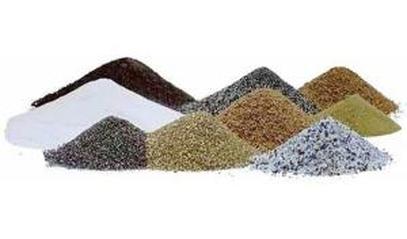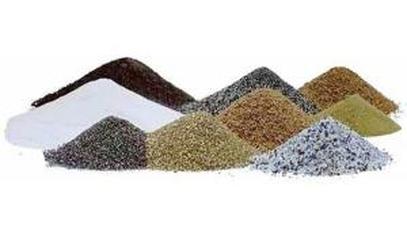
Los abrasivos y su correcta elección, es la parte más importante y difícil a la hora de establecer un proceso de chorreado o de granallado. Es necesario saber el tipo de abrasivo a emplear, por ejemplo, a la hora de conseguir un acabado superficial determinado, una limpieza, decapado o grabado dentro de un proceso industrial, para conseguir acabados perfectos y exentos de residuos ni materiales contaminantes, etc.
Existen muchos tipos de abrasivos pero, para el chorreado o el granallado, existen materiales muy conocidos en nuestro sector, como por ejemplo:
CHORREADO
• Microesferas de vidrio (sin sílice libre)
• Corindón blanco y marrón (óxido de aluminio)
• Granalla cerámica (zirconio)
• Granalla plástica
• Abrasivo vegetal (cáscara nuez y almendra)
GRANALLADO
• Granalla de acero
• Granalla de acero inoxidable
• Granalla de acero al cromo
El gran ausente en esta lista de abrasivos es la “arena de sílice”, porque su uso produce silicosis, una grave enfermedad de las vías respiratorias por inhalación de partículas de sílice libre que son liberadas entre el polvo generado, al romperse la arena durante el proceso de chorreado. ABSHOT en su política de Seguridad Laboral y de respeto al Medioambiente, nunca ha tenido entre sus productos la arena de sílice.
Cualquiera de los abrasivos mostrados en la lista anterior, están exentos de sílice libre y de cualquier elemento contaminante. ABSHOT dispone de la ficha técnica y ficha de seguridad de loa abrasivos distribuidos, y de toda la documentación necesaria facilitada por el propio fabricante.
FACTORES PARA UN CORRECTO ACABADO.
Tan importante es conseguir el acabado superficial deseado, como conseguir un equilibrio entre los costes y la efectividad del tratamiento con chorro abrasivo. Hay varios factores relacionados con el abrasivo que, junto con el equipo de chorreado o granallado a utilizar, determinan el acabado final:
A) TAMAÑO:
El tamaño de las partículas determinará la rugosidad obtenida. Si fijamos la presión y el caudal de aire, al variar el tamaño del grano nos variará la rugosidad conseguida por el impacto de la partícula abrasiva sobre la superficie. Es decir, a mayor tamaño de la partícula, mayor es la huella que deja en el material chorreado.
Los fabricantes de abrasivo utilizan varias nomenclaturas y numeraciones para definir el tamaño de cada grano, pero normalmente se rigen por la normativa FEPA que marca los estándares de tamaño.
B) FORMA:
Los abrasivos tienen dos morfologías típicas, la esférica y la angular. Por regla general, un abrasivo esférico desgasta menos el equipo de chorreado o granallado, el acabado superficial es más suave al tacto (ya que la rugosidad superficial no tiene picos, sino que tiene forma de “ondas” debido al impacto de las esferas) y el proceso de chorreado suele ser más lento.
Por el contrario, un abrasivo angular desgasta mucho más el equipo de chorreado o granallado, el acabado superficial es áspero al tacto (ya que la rugosidad superficial tiene forma de “sierra” debido al impacto del abrasivo con aristas) y el proceso suele ser más rápido, ya que es mucho más agresivo que con un abrasivo esférico.
Como resumen, podemos decir que el abrasivo angular trabaja mejor cuando se trata de desprender o decapar capas de pintura y de corrosión; mientras que el abrasivo esférico, en cambio, es mejor para espesores menores y acabados finos, satinados y procesos de shot peening para eliminar tensiones superficiales en las piezas.
C) DENSIDAD:
La densidad es el peso del abrasivo por volumen. Esta es la característica menos determinante que se tiene que tomar en cuenta para realizar un trabajo de chorreado o granallado, excepto si la diferencia de densidades entre los abrasivos elegidos es muy amplia.
En la medida en que el material sea más denso, mayor será la energía con que se impacte contra la superficie. Es decir, que un abrasivo más pesado que otro puede dejar una huella más profunda que otro abrasivo mucho más ligero.
D) DUREZA:
La dureza del abrasivo determinará su efecto sobre la superficie que va a ser chorreada o granallada. Si el abrasivo es más duro que la superficie del material a chorrear, se produce el decapado (o la deformación) de la superficie a tratar, ya que el abrasivo es más resistente que el material contra el que impacta.
Por el contrario, si el abrasivo es más blando o más suave que la superficie del material a chorrear, el abrasivo solamente removerá el recubrimiento encima de la superficie del material (pintura, oxido, etc.) ya que el abrasivo es menos resistente que el material contra el que se impacta y rebota, tras dicho impacto, sin dejar huella superficial.
Por lo tanto, una dureza excesiva del abrasivo a chorrear con respecto a la dureza de la superficie a tratar, puede provocar deformaciones en la pieza e incluso desgastes prematuros en el equipo de chorreado o de granallado.
La dureza del abrasivo se mide según la escala de Mohs, siendo el valor 1 de la escala tan suave como el talco, y el valor 10 materiales tan duros como el diamante.
Si clasificamos los abrasivos de mayor a menor dureza, vemos que el corindón blanco y el corindón marrón tienen una dureza 9 Mohs, le sigue la granalla cerámica con unos 7 Mohs, las microesferas de vidrio unos 6 Mosh, igual que el silicato de aluminio, y después vienen el abrasivo vegetal y la granalla plástica con unos 3 Mohs aproximadamente.
Las granallas metálicas de acero y de acero inoxidable se miden normalmente en Rockwell (HRC). La granalla de acero se diferencia por ser de baja (46-51 HRC), media (53-57 HRC) y alta dureza (>64 HRC). La granalla de acero inoxidable tiene una dureza en origen de 30 HRC y, a medida que se usa, alcanza una dureza en operación de 45 HRC., existen también granallas de acero inoxidable de hasta 63-65 HRC de dureza.


¿Necesitas ayuda?
Nuestro equipo de Ventas estará encantado de ofrecerte una solución adaptada a tu negocio.
Contacta con Ventas